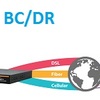Ronald van der Breggen, Chief Commercial Officer at LEOSAT, agreed to an interview after WAN Summit NYC that we both attended.
RAD: What does LEOSAT do?
Ronald van der Breggen: LEOSAT is launching an MPLS network in space at 1440 km altitude. Once accessing this constellation of MPLS routers (mounted on satellites), we can carry traffic from anywhere to everywhere with lower latency than fiber and with capacities in the Gigabit range. Whether one wants to go from an Oil rig in the Gulf of Mexico to a mountain top in the Himalayas or from the middle of NYC to Abu Dhabi, this constellation will allow you to setup the connection almost instantly with a performance and security that exceeds fiber.
Interesting that they would setup an MPLS network now when everyone says MPLS is dead.
RAD: What did LEOSAT expect to get out of WAN Summit?
Ronald van der Breggen: Satellites are traditionally perceived as slow and expensive. So first and foremost we wanted to change that perception to one of satellites 'providing real solutions for global data-networking'. LeoSat can e.g. help Telecom operators to connect their global customers faster, help them in providing ultra-secure networking (LeoSat carries traffic physically separated from terrestrial networks), help them with connecting mobile sites, off-shore sites and sites in harsh environments. All of this can be done either as a last mile solution or as a more secure end-to-end solution. The list of options goes on and on and working with resellers and customers in Maritime, Enterprise, Media, Government, Oil&Gas and Mobile, we're enthused by hearing so many new application areas on an almost daily basis.
Ronald van der Breggen: At the WAN Summit, we enjoyed a lot of enthusiastic responses that lead to quite a few follow up meetings.
RAD: How is latency faster on a satellite than on a terrestrial network?
Ronald van der Breggen: Latency is indeed a lot lower, NYC-Tokyo is under 100ms, whereas terrestrial is 150-170ms. Even if a straight cable were built, we'd still be 20ms faster. As light traveling in a fiber optic cable travels at 2/3 of the speed of light, we start showing latency advantages when cable length starts exceeding 5000 km. Every satellites adds roughly 2ms in latency (conservative estimate). For extra proof read the Leosat FAQ
A press release that he sent to me: LeoSat Enterprises Contracts First Customer: Faster than fiber: Leosat's lowest-latency solution expected to revolutionize data connectivity in financial trading sector.













